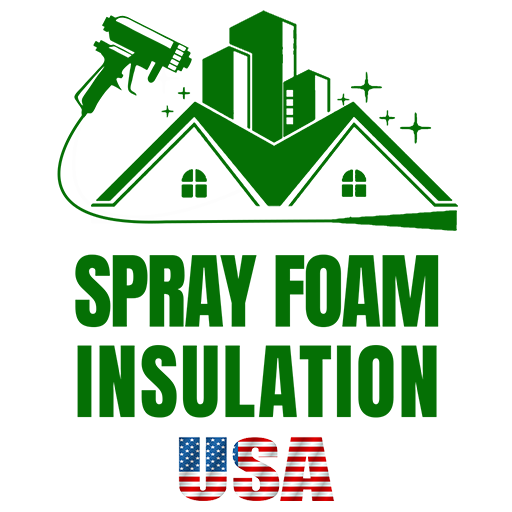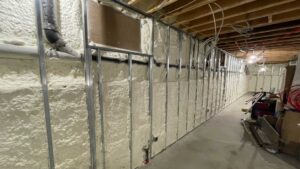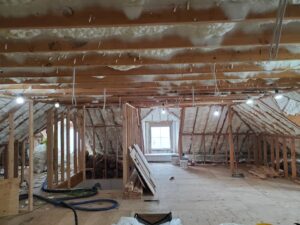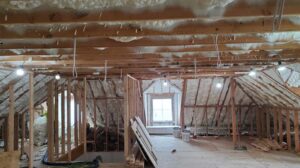Introduction
Understanding the ‘attic insulation r value’ is crucial for any homeowner or business owner looking to enhance their property’s energy efficiency and comfort. The R-value measures the insulation’s resistance to heat flow; higher values mean better insulation. This is particularly important in attics where heat can easily escape or enter, heavily influencing your heating and cooling costs.
- High R-value: Better insulation, less heat flow
- Energy Savings: Lower heating and cooling costs
- Enhanced Comfort: More stable indoor temperatures year-round
Attic insulation is not just about saving money; it’s also about living more comfortably. Insulating your attic properly can keep your home warmer in the harsh winters of New York and cooler during the hot New Jersey summers, all while reducing the environmental impact and energy consumption. This initial step towards upgrading your attic’s insulation can set the stage for a full suite of benefits that extend beyond simple cost savings.

Understanding R-Value
What is R-Value?
R-value is a term that might sound technical, but it’s actually pretty simple. It measures how well insulation can resist the flow of heat. Think of it as a blanket’s thickness; however, instead of measuring how fluffy the blanket is, R-value measures how effective it is at keeping warmth from escaping. The higher the R-value, the better the insulation’s ability to keep heat in during winter and out during summer.
Why Does Heat Flow Resistance Matter?
Heat naturally moves from warmer to cooler areas until there is no longer a temperature difference. In homes, this means that in winter, heat moves from heated living spaces to the colder outdoors or unheated attics and garages. Conversely, in summer, heat moves from the hot outdoors into the cooler interior of the home. Proper insulation, with a high attic insulation R-value, slows this heat flow, maintaining comfortable temperatures inside and reducing energy use.
Importance in Insulation
The importance of R-value in insulation cannot be overstated:
- Energy Efficiency: Insulation with a proper R-value can significantly reduce the amount of energy needed for heating and cooling, which lowers utility bills.
- Comfort: Effective insulation helps keep the environment inside your home consistent by reducing the drafts and cold spots that can occur in poorly insulated spaces.
- Environmental Impact: By using less energy to heat and cool your home, you’re also reducing your home’s carbon footprint, contributing to less strain on power plants and fewer greenhouse gas emissions.
Understanding the R-value is essential for choosing the right insulation for your attic and ensuring it performs effectively to enhance comfort and energy efficiency in your home. The next section will delve into the recommended R-values for attic insulation based on various climate zones and building codes.
Recommended R-Values for Attic Insulation
When it comes to attic insulation, attic insulation R-value is a key factor that determines how well your insulation will perform. The right R-value can help keep your home warm in the winter and cool in the summer, leading to lower energy bills and a more comfortable living environment. Let’s dive into how to select the appropriate R-value for your attic based on climate zones, the International Energy Conservation Code (IECC) guidelines, and considerations for retrofitting existing buildings.
Climate Zones and Their Impact on R-Value
The United States is divided into several climate zones, each requiring a different level of insulation to achieve optimal energy efficiency:
- Zone 1 (Hot): Includes areas like Miami. A lower R-value, such as R30 to R49, is typically sufficient.
- Zones 2 and 3 (Moderate): Covers cities like Houston and Atlanta. Recommended R-values range from R38 to R60.
- Zones 4 to 6 (Mixed): This includes places like New York and Chicago, where R49 to R60 is advisable to handle both hot summers and cold winters.
- Zones 7 and 8 (Cold): Encompasses regions like Minnesota and Alaska, requiring the highest R-values of R49 to R60 to keep the warmth in during harsh winters.
These recommendations ensure that your attic insulation provides adequate resistance to heat flow, which is crucial in maintaining energy efficiency and comfort.
Following IECC Guidelines
The IECC sets forth building codes that include specific insulation requirements to promote energy conservation. The 2021 IECC guidelines suggest varying R-values for attic insulation based on the climate zone your home is located in. Adhering to these codes not only helps in optimizing your home’s energy usage but also ensures compliance with local building regulations, which can be crucial during renovations or when building a new home.
Retrofitting Existing Buildings
If you’re upgrading the insulation in an existing home, understanding the current insulation levels is crucial. Many older homes may have insulation that falls short of modern standards. Here’s what you should consider:
- Uninsulated Attics: If you have no existing insulation, aim for the highest recommended R-value for your climate zone.
- Partially Insulated Attics: If your attic already has some insulation, you might not need to start from scratch. Instead, you can add more insulation to achieve the recommended R-value. For example, if you already have R30 and you need R60, you only need to add an additional R30.
Retrofitting provides a significant opportunity to enhance energy efficiency and comfort in older homes. By bringing the insulation up to current standards, you can see substantial reductions in energy costs and improvements in overall home comfort.
Conclusion
Choosing the right attic insulation R-value is essential for maximizing energy efficiency and maintaining a comfortable home environment. By considering your climate zone, adhering to IECC guidelines, and properly assessing the needs of your existing insulation, you can make informed decisions that lead to long-term benefits. Whether you’re building a new home or retrofitting an old one, investing in the right attic insulation is a smart move towards a more sustainable and comfortable home.
In the next section, we’ll explore the different types of attic insulation materials and their respective R-values, helping you make the best choice for your insulation needs.
Types of Attic Insulation and Their R-Values
When it comes to choosing the right attic insulation, understanding the different types and their R-values is crucial. Let’s dive into the most common materials used for attic insulation: Fiberglass, Cellulose, Spray foam, and Rock wool.
Fiberglass Insulation
Fiberglass is one of the most popular types of insulation. It comes in batts and rolls, making it easy to install between attic rafters and floor joists.
- R-Value: Typically ranges from R-2.2 to R-4.0 per inch.
- Pros: Cost-effective, non-flammable, and resistant to moisture damage.
- Cons: Can be irritating to the skin and lungs during installation, does not provide a complete air seal.
Cellulose Insulation
Made from recycled paper treated with fire retardant, cellulose is an eco-friendly option. It’s often applied using a wet-spray technique, which helps it conform to irregular spaces in attics.
- R-Value: Around R-3.1 to R-3.8 per inch.
- Pros: Excellent thermal performance, eco-friendly, and good for attics with irregular shapes.
- Cons: Can settle over time, which may reduce its effectiveness.
Spray Foam Insulation
Spray foam offers a high-performance solution that seals air leaks and insulates simultaneously. There are two types: open-cell and closed-cell, with the latter providing a higher R-value.
- R-Value: Open-cell spray foam has about R-3.5 to R-3.6 per inch, while closed-cell can reach R-6.0 to R-6.5 per inch.
- Pros: Provides an air seal, high R-value, and structural strength to the attic.
- Cons: More expensive than other options and must be installed by professionals.
Rock Wool Insulation
Also known as mineral wool, rock wool is made from natural minerals and offers excellent fire resistance and sound insulation.
- R-Value: Generally around R-3.0 to R-3.3 per inch.
- Pros: Fire-resistant, effective at blocking noise, and does not require special handling like fiberglass.
- Cons: Can be more expensive than fiberglass and is heavier, which might require additional support structures in the attic.
By understanding the R-values and properties of these insulation materials, you can choose the one that best fits your home’s needs and your personal preferences. Always consider your attic insulation R-value to ensure optimal energy efficiency and comfort in your home.
In the following section, we’ll guide you on how to determine your attic’s current R-value and assess whether an upgrade is necessary. This step is crucial for enhancing your home’s energy efficiency and ensuring a comfortable living environment year-round.
How to Determine Your Attic’s Current R-Value
Determining the existing R-value of your attic insulation is a key step in assessing whether you need an upgrade. This process involves a few straightforward steps: inspecting the insulation, measuring its depth, and calculating its total R-value. Let’s walk through each of these steps to help you get a clear picture of your attic’s insulation status.
Inspection Tips
First, safety is crucial. Equip yourself with gloves, a mask, and goggles to avoid irritation from insulation materials. Make sure your attic is well-lit and safe to navigate.
Start by visually inspecting the insulation in your attic. Look for any signs of damage like dampness, mold, or areas where the insulation has been compressed or disturbed. These issues can significantly reduce the effectiveness of your insulation.
Measuring Depth
To measure the depth of your insulation, use a ruler or a measuring tape. Gently place it into the insulation until it hits the attic floor, then record the depth. Perform this measurement at various points throughout the attic to get an average depth. Variations can occur, and some areas might be less insulated than others.
Calculating Total R-Value
Once you have the depth, you can calculate the total R-value using the type of insulation material:
- Fiberglass (loose or batts): Typically has an R-value of about 2.5 to 3.2 per inch.
- Cellulose: Generally offers about 3.7 per inch.
- Rock wool: Provides approximately 2.8 per inch.
- Vermiculite or perlite: Around 2.7 per inch.
Multiply the depth in inches by the R-value per inch for the specific type of insulation you have. For example, if you have 10 inches of fiberglass batt insulation, you would calculate it as follows: 10 inches x 3.2 R-value per inch = 32 R-value.
This calculated R-value helps you understand the current level of insulation in your attic. Comparing this number with the recommended R-values for your climate zone (as detailed in earlier sections) will indicate whether additional insulation is needed.
By following these steps, you can accurately determine the attic insulation R-value and make informed decisions about potential upgrades. This is essential for maintaining an energy-efficient and comfortable home environment. If you find that your insulation is lacking, consider consulting with professionals like those at Spray Foam Insulation USA to discuss your options for enhancement.
Enhancing Your Attic Insulation
Improving your attic’s insulation is crucial for energy efficiency and creating a comfortable living space. Let’s explore your options, from DIY projects to professional installation, conduct a cost-benefit analysis, and consider sustainable materials.
DIY vs. Professional Installation
DIY Installation: Opting to install attic insulation yourself can be cost-effective and gratifying. It’s suitable for those who have some experience with home improvement projects and can spare the time. However, DIY might involve risks like incorrect installation or inadequate insulation coverage.
- Pros: Save on labor costs; complete on your own schedule.
- Cons: Potential for mistakes; lack of professional tools and expertise.
Professional Installation: Hiring experts like those at Spray Foam Insulation USA ensures that your attic insulation is installed correctly and efficiently. Professionals can assess your attic’s specific needs and recommend the best insulation type and R-value.
- Pros: Expert installation; quick and efficient service; access to higher-quality materials.
- Cons: Higher initial cost.
Cost-Benefit Analysis
When deciding between DIY and professional installation, consider both the immediate costs and long-term savings. Professional installation might seem more expensive upfront, but it can lead to greater energy savings due to proper installation techniques. DIY, while cheaper initially, might not provide the same level of insulation effectiveness, potentially leading to higher energy bills over time.
Sustainable Options
In an era where environmental impact is a significant concern, choosing sustainable insulation materials is a responsible decision. Here are a few eco-friendly options:
- Recycled Denim: This material provides excellent thermal performance and is free from chemicals. It’s an innovative way to recycle waste while improving your home’s insulation.
- Wool: Natural, renewable, and with good insulation properties, wool is a fantastic choice for those looking to reduce their ecological footprint.
- Cellulose: Made from recycled paper, cellulose is treated to be fire resistant and insect repellent, offering both sustainability and durability.
Choosing sustainable materials not only helps the environment but can also enhance the air quality in your home and contribute to overall energy efficiency.
By considering these aspects, you can make well-informed decisions that balance cost, effectiveness, and environmental impact. Whether you choose to DIY or hire professionals like Spray Foam Insulation USA, enhancing your attic insulation is a smart move towards a more energy-efficient and comfortable home.
Common Misconceptions About Attic Insulation
When it comes to attic insulation, there are a few common myths that can lead to confusion and less-than-optimal energy efficiency. Let’s clear up some of these misconceptions about attic insulation R value, thickness versus efficiency, material differences, and maintenance needs.
Thickness vs. Efficiency
A common belief is that the thicker the insulation, the more effective it will be. However, this isn’t always the case. Attic insulation R value is a measure of resistance to heat flow, not just a function of thickness. For instance, different materials have different insulating properties. Spray foam might have a higher R-value per inch compared to fiberglass. So, a thinner layer of spray foam could potentially outperform a thicker layer of fiberglass insulation.
Material Differences
Not all insulation materials are created equal. Each type has its own unique properties that make it suitable for different situations:
- Fiberglass: Commonly found in batt form, it’s versatile and easy to install. However, it can settle over time and lose some insulating capabilities.
- Cellulose: Made from recycled paper products and treated for fire resistance. It’s good for blocking air leaks but can be prone to settling.
- Spray Foam: Provides excellent air sealing and moisture resistance. It tends to have a higher R-value per inch, making it a potent choice for both insulation and air sealing.
Choosing the right material depends on your specific needs, climate, and the area you are insulating.
Maintenance Needs
Insulation isn’t just a “set it and forget it” solution. Over time, insulation can settle, get wet, or become infested with pests, all of which can degrade its effectiveness. Regular inspections are crucial. Look for areas where insulation might have moved away from where it should be or where it might have become compressed. These issues can significantly diminish the R-value and effectiveness of the insulation.
It’s also important to check for moisture, as wet insulation can lead to mold growth and a significant reduction in R-value. Ensuring that your attic has proper ventilation can prevent moisture buildup and help maintain the effectiveness of your insulation.
By understanding these common misconceptions, you can make more informed decisions about your attic insulation. The right R-value and proper installation are key to maximizing energy efficiency and comfort in your home. If you’re unsure, consulting with professionals like Spray Foam Insulation USA can provide you with the expertise needed to ensure your attic is properly insulated.
Conclusion
As we wrap up our comprehensive guide on attic insulation and the significance of attic insulation R value, it’s clear that the right insulation can greatly enhance your home’s energy efficiency and overall comfort. By understanding and implementing the proper R-values, you can enjoy substantial energy savings and a more consistent indoor environment.
Energy Savings: One of the most compelling reasons to invest in high-quality attic insulation is the potential for significant energy savings. With proper insulation, such as the solutions provided by Spray Foam Insulation USA, your heating and cooling systems don’t have to work as hard to maintain a comfortable temperature. This reduction in energy consumption can lead to lower utility bills, making insulation upgrades a smart financial decision in the long run.
Home Comfort: Beyond the savings, the comfort of your living space is greatly enhanced with the right attic insulation. Proper insulation helps maintain a steady temperature throughout your home, eliminating hot or cold spots that can be a discomfort during extreme weather. Additionally, high-quality spray foam insulation can help reduce noise from outside, ensuring that your home remains a peaceful sanctuary.
At Spray Foam Insulation USA, we are dedicated to providing you with top-tier insulation that suits your specific needs. Our spray foam solutions are designed not only to meet but exceed the recommended R-values, ensuring that your home achieves maximum energy efficiency and comfort. Whether you’re upgrading an old attic or insulating a new one, our expert team is here to guide you every step of the way.
In conclusion, investing in the right attic insulation is not just about improving energy efficiency—it’s about enhancing the overall quality of life in your home. With the support of Spray Foam Insulation USA, you can rest assured that your attic is well insulated, making your home more energy-efficient, comfortable, and environmentally friendly. Don’t wait to make this valuable improvement; contact us today for a free estimate and take the first step towards a better-insulated home.





